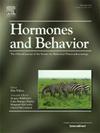Role of interdependent self-construal in predicting acute salivary cortisol response, hair cortisol concentrations, and their associations
IF 2.5
3区 医学
Q2 BEHAVIORAL SCIENCES
引用次数: 0
Abstract
Numerous studies have associated interdependent self-construal (InterSC) with heightened acute salivary cortisol stress responses in collectivist cultures. Hair cortisol concentration (HCC) is an important biomarker of chronic stress and is associated with acute salivary cortisol stress response. However, few studies have explored the association between InterSC and HCC. This study aimed to investigate the role of InterSC in the acute salivary cortisol stress response, HCC, and their associations. Seventy-seven healthy Chinese participants underwent assessments of InterSC, social anxiety, and HCC. The ScanSTRESS paradigm was used to induce an acute stress response and saliva samples were collected. These results replicated earlier findings showing that InterSC was associated with rapid salivary cortisol reactivity and recovery during acute stress. Additionally, InterSC was positively correlated with HCC, and social anxiety mediated this association. Importantly, InterSC moderated the HCC–acute salivary cortisol stress response association. Specifically, high HCC predicted a blunted acute salivary cortisol stress response in participants with low InterSC, including a slow salivary cortisol response during the acute stress reactivity phase and a small overall acute salivary cortisol response. However, this blunting effect was not observed with high InterSC participants, indicating that high InterSC buffered the blunting effect of HCC on the acute salivary cortisol stress response. In conclusion, this study provided new insights into how InterSC is associated with the hypothalamus-pituitary-adrenal axis stress system and revealed the dual-faceted role of InterSC for acute salivary cortisol stress and HCC.
相互依存的自我暗示在预测急性唾液皮质醇反应、毛发皮质醇浓度及其关联中的作用。
大量研究表明,在集体主义文化中,相互依存的自我结构(InterSC)与急性唾液皮质醇应激反应的增强有关。毛发皮质醇浓度(HCC)是慢性压力的重要生物标志物,与急性唾液皮质醇压力反应有关。然而,很少有研究探讨了 InterSC 与 HCC 之间的关联。本研究旨在探讨唾液皮质醇间充质干细胞在急性唾液皮质醇应激反应和 HCC 中的作用及其相关性。77 名健康的中国参与者接受了 InterSC、社交焦虑和 HCC 评估。采用 ScanSTRESS 范式诱导急性应激反应,并采集唾液样本。这些结果重复了之前的研究结果,即 InterSC 与唾液皮质醇在急性应激反应中的快速反应和恢复有关。此外,InterSC 与 HCC 呈正相关,而社交焦虑是这种关联的中介。重要的是,InterSC调节了HCC与急性唾液皮质醇应激反应的关系。具体来说,高HCC预示着低InterSC参与者的急性唾液皮质醇应激反应会减弱,包括在急性应激反应阶段唾液皮质醇反应缓慢以及总体急性唾液皮质醇反应较小。然而,在间充质干细胞含量高的参与者中却没有观察到这种钝化效应,这表明高间充质干细胞含量缓冲了 HCC 对急性唾液皮质醇应激反应的钝化效应。总之,这项研究为了解间充质干细胞如何与下丘脑-垂体-肾上腺轴应激系统相关联提供了新的视角,并揭示了间充质干细胞在急性唾液皮质醇应激和 HCC 中的双重作用。
本文章由计算机程序翻译,如有差异,请以英文原文为准。
求助全文
约1分钟内获得全文
求助全文
来源期刊

Hormones and Behavior
医学-行为科学
CiteScore
6.70
自引率
8.60%
发文量
139
审稿时长
91 days
期刊介绍:
Hormones and Behavior publishes original research articles, reviews and special issues concerning hormone-brain-behavior relationships, broadly defined. The journal''s scope ranges from laboratory and field studies concerning neuroendocrine as well as endocrine mechanisms controlling the development or adult expression of behavior to studies concerning the environmental control and evolutionary significance of hormone-behavior relationships. The journal welcomes studies conducted on species ranging from invertebrates to mammals, including humans.
 求助内容:
求助内容: 应助结果提醒方式:
应助结果提醒方式:


